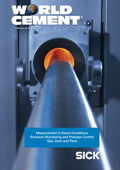Editorial comment
Disasters on the scale of the devastating earthquake that struck Haiti on 12 January have a way of uniting people and nations in a way that few other events can. The news is full of stories of generosity and heroism, as both countries and individuals devote time, money and resources to help those in Port-au-Prince who have lost so much. As efforts move from rescue to recovery, international experts and world leaders gather to discuss reconstruction.
Register for free »
Get started now for absolutely FREE, no credit card required.
The tragedy in Haiti has been compounded by the country’s extreme poverty. That and a lack of building regulations have led to inadequate construction standards that have exacerbated this natural disaster to the point that much of the devastation can be called manmade. According to Michael Havbro Faber, a professor of risk and safety at the Federal Institute of Technology in Zurich, Switzerland, the buildings in Port-au-Prince ‘are in no way designed for earthquake loadings and other severe natural events’. This was evidenced in 2004 when a minor hurricane tore through Gonaïves, killing 3000 and displacing 250 000, where in another country it may simply have damaged property. As Faber puts it: ‘It’s not that these people intend to do things wrong. It’s not that we don’t know this threat is there…(They) invest as much into their buildings as they can afford...’, but they cannot afford a lot. Fundamentally, without sufficient time and investment into rebuilding, the country will remain at risk.When it comes to reconstruction, no doubt the firsthand experience of those involved in the clean-up and rebuild following the Sichuan earthquake in May 2008 and the 26 December tsunami in 2004 will play a major part in the discussions. Some 60 000 died in Sichuan, but temporary accommodation was established within 6 months to house the majority of the 5 million rendered homeless. The efficiency with which the Chinese government dealt with the impact of the 'quake was the subject of admiration from aid agencies, and China has been among the countries quick to offer support to Haiti in the form of money and supplies. The tsunami clean-up is, in some respects, still underway, although much has been achieved over the last five years. Utilising this experience, Robert Zoellick, President of the World Bank, which provided a US$700 million fund to help rebuild Aceh in Indonesia, emphasised the need to think long-term with regards to helping Haiti. In an interview with the Financial Times, he discussed the ultimate goal: to ‘build back better’, and indicated his resolve to make sure that the country grasps the opportunity to turn things around and ‘rebuild for the future’. For this, of course, Haiti will need cement. Cemex, which has terminals in Haiti, one of which is still operational, has already announced the establishment of a fund through which employees can donate to the relief effort, and has pledged to match those donations two-for-one. Heidelberg Cement, which does not have production facilities in the area, has made a considerable donation to the Red Cross to help fund the construction of a mobile hospital, and to improve the delivery of clean drinking water. Preliminary reports suggest that the 600 000 tpa plant owned by Cementos Argos, situated some 25 km from Port-au-Prince, has not been damaged, which will benefit the reconstruction efforts when the time comes. Cement manufacturing facilities in neighbouring countries, such as the Dominican Republic, will also be called upon to supply materials for the reconstruction work. In a situation where everyone is committed to doing what they can, it will be the responsibility of the cement industry to meet demand in Haiti with high-quality products.


